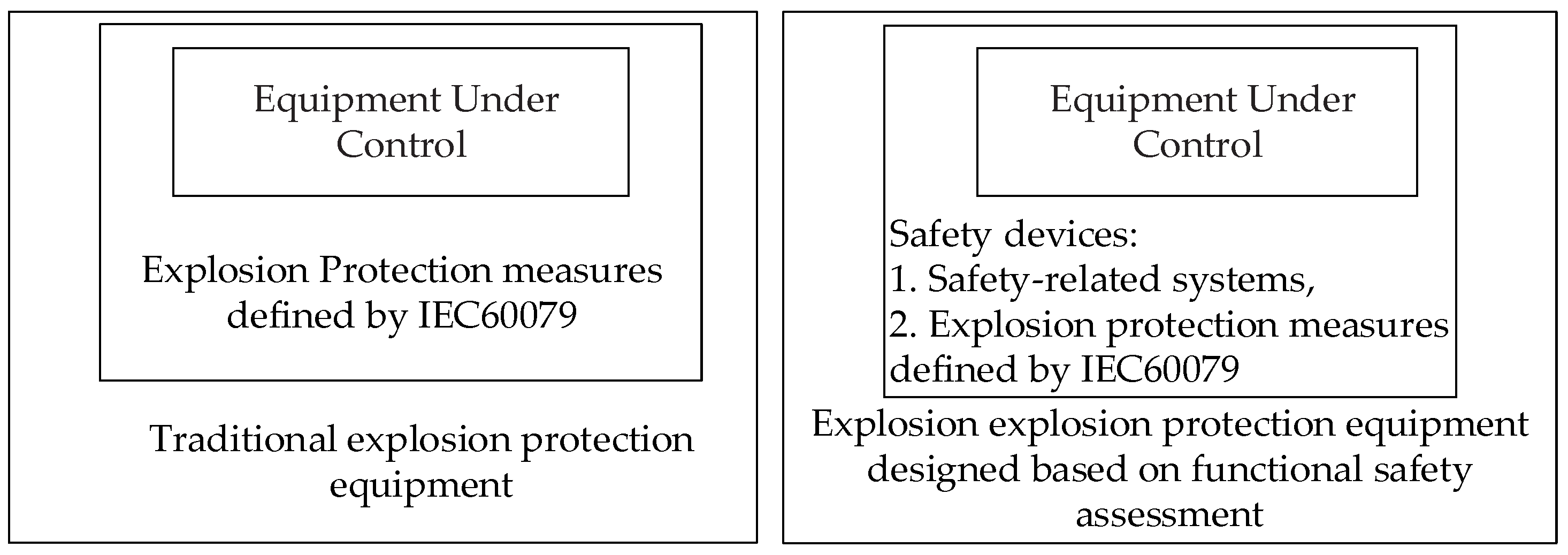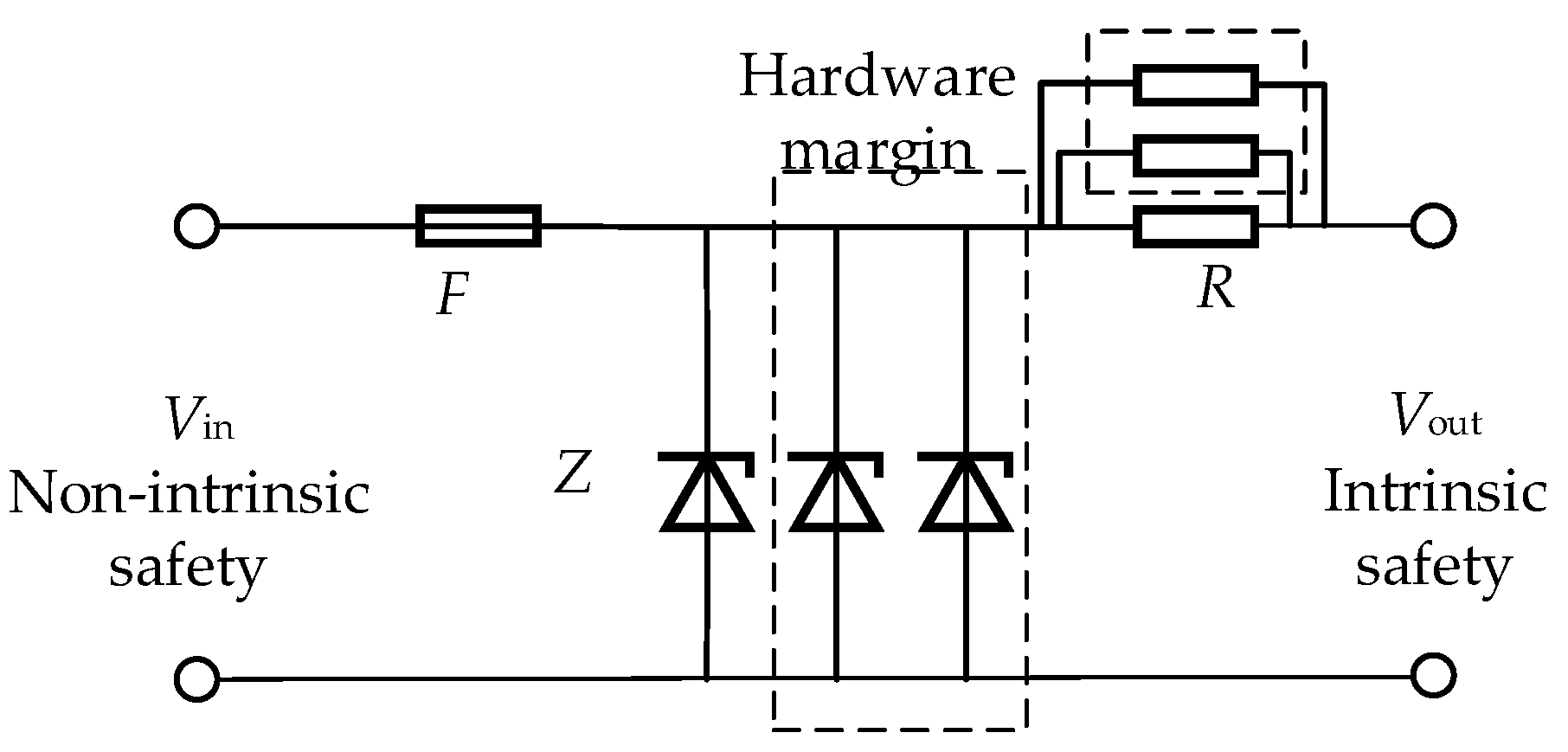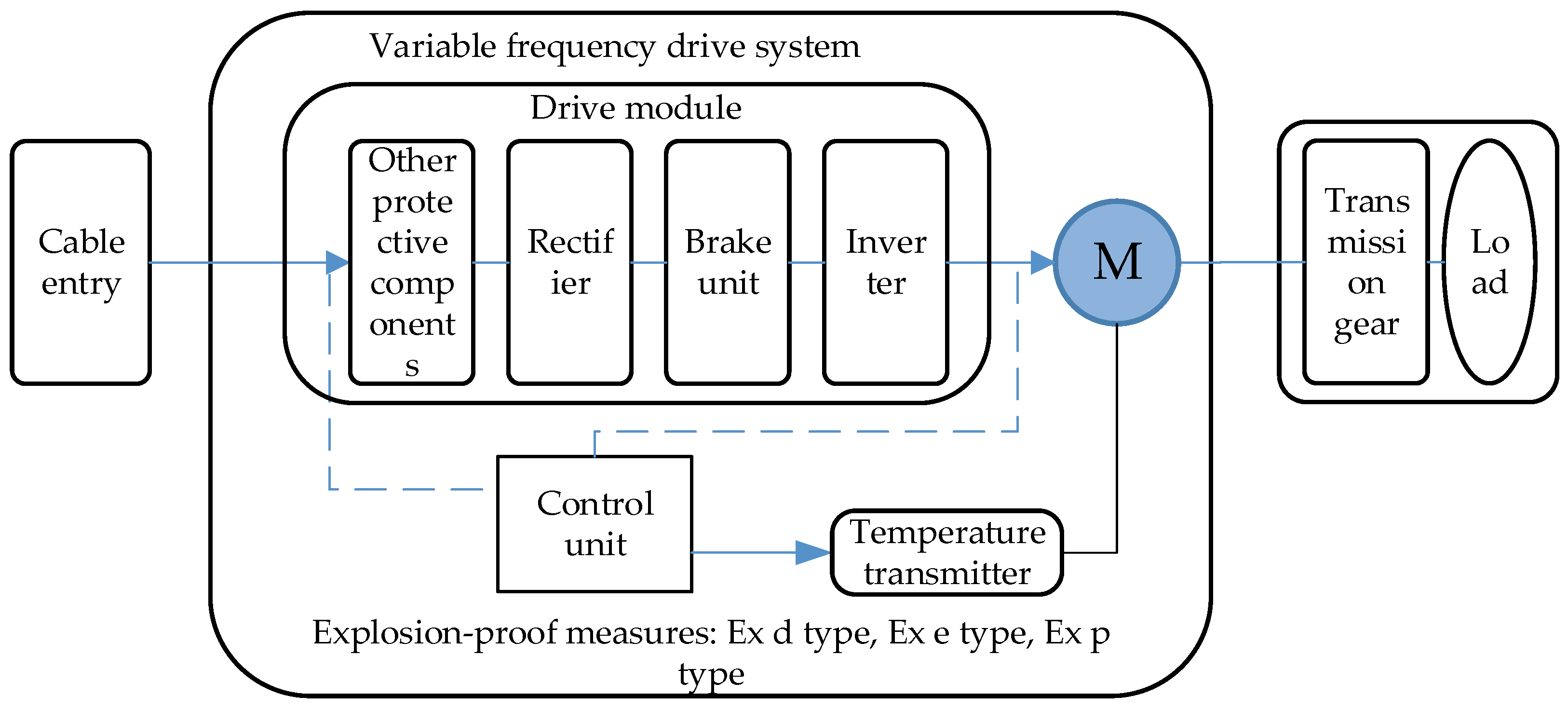A Functional Safety Assessment Methodology for Explosion Protection with Application to a Variable Frequency Drive System
Abstract
:1. Introduction
2. Functional Safety and Explosion Protection Function
3. Proposed Methodology for Evaluation of the Explosion Protection Equipment’s Protection Levels (EPLs) Based on an Assessment of Functional Safety
3.1. Potential Ignition Source Analysis and Explosion Protection Function Identification
3.2. Failure Mode and Effect Analysis (FMEA)
3.3. Failure Analysis and Failure Rate Calculation of Safety Devices
3.3.1. Failure Analysis of Flameproof (Ex d) Type
- 1.
- Failure Analysis for Strength of Enclosure
- 2.
- Failure Analysis for Width of Joints
- 3.
- Failure Analysis Sealing Performance for Cable Glands
- 4.
- Failure Analysis of Flameproof Gap
3.3.2. Failure Analysis of Increased Safety Explosion Protection Function
3.3.3. Failure Analysis of Intrinsically Safe Circuit Explosion Protection Function
3.3.4. Failure Analysis of Equipment under Control
- 1.
- Failure Analysis of Functional Components
- 2.
- Failure of Electrical Protection Components
3.3.5. Failure Analysis of E/E/PE Safety-Related System
3.4. Determination of SIL
3.5. EPLs Evaluation Based on SIL
4. Application on VFD System
4.1. Composition of VFD System and Safety Device in Explosive Environment
4.2. SIL Level Verification of Explosion Protection VFD System
- 1.
- The system consists of a flameproof-type frequency converter and flameproof-type motor. The failure rate of the system should be the sum of two parts:
- 2.
- The system consists of a flameproof-type frequency converter and increased safetytype motor. The failure rate of the system should be the sum of two parts:
- 3.
- The system is composed of a flameproof frequency converter and increased safety motor. The motor adds a temperature control module for additional temperature protection on the basis of increased safety protection. The temperature control of the whole motor will fail only if the temperature control function of the increased safety construction and the temperature control module fail at the same time. We assume the failure rate of the increased safety construction to be as follows: a 50% spark ignition failure rate and a 50% temperature control failure rate:
5. Conclusions
- The traditional explosion protection equipment defined in IEC60079-ff can be considered as safety devices and used for functional safety assessments.
- The failure mode and effect of the explosion protection type as a safety device were analyzed, and the method for calculating the failure rate of an explosion protection type was given.
- An increased safety VFD system with a safety temperature control device can improve the EPL level for Zone 1.
- An improved explosion protection function safety assessment method was proposed to achieve an EPL safety level that cannot be achieved by the traditional IEC60079-ff explosion protection equipment, via a flexible configuration of the explosion protection and E/E/PE safety devices.
Author Contributions
Funding
Data Availability Statement
Conflicts of Interest
References
- Langeron, Y.; Barros, A.; Grall, A.; Bérenguer, C. Combination of safety integrity levels (SILs): A study of IEC61508 merging rules. J. Loss Prevent. Proc. 2008, 21, 437–449. [Google Scholar] [CrossRef]
- Kosmowski, K.T. Functional safety concept for hazardous systems and new challenges. J. Loss Prevent. Proc. 2006, 19, 298–305. [Google Scholar] [CrossRef]
- Lebecki, K. Functional Safety in Industrial Explosion Protection. Trans. VŠB Tech. Univ. Ostrav. Saf. Eng. Ser. 2012, VII, 44–48. [Google Scholar] [CrossRef] [Green Version]
- Faranda, R.S.; Fumagalli, K.; Bielli, M. Lithium-ion batteries for explosive atmosphere. In Proceedings of the 2019 Petroleum and Chemical Industry Conference Europe (PCIC Europe), Paris, France, 7–9 May 2019. [Google Scholar]
- Fumagalli, K.; Martina, M.; Corbo, P. Light emitting diodes (LED) for installation in zone 1: A feasible procedure to determine the equivalent protection level. In Proceedings of the 2015 Petroleum and Chemical Industry Conference Europe (PCIC Europe), Berlin, Germany, 14–16 June 2016. [Google Scholar]
- Smith, D.J.; Simpson, K.G. Safety Critical Systems Handbook: A Straight Forward Guide to Functional Safety, IEC 61508 (2010 Edition) and Related Standards, Including Process IEC 61511 and Machinery IEC 62061 and ISO 13849; Elsevier: Amsterdam, The Netherlands, 2010; ISBN 0080967825. [Google Scholar]
- Jespen, T. ATEX—Ignition sources. In ATEX—Explosive Atmospheres; Springer: Berlin/Heidelberg, Germany, 2016; pp. 163–169. [Google Scholar]
- Explosion Prevention and Protection. Basic Concepts and Methodology; EN 1127-1 (2001); European Committee for Standardisation: Brussels, Belgium, 1997.
- Catelani, M.; Ciani, L.; Luongo, V. The FMEDA approach to improve the safety assessment according to the IEC61508. Microelectron. Reliab. 2010, 50, 1230–1235. [Google Scholar] [CrossRef]
- Magyari, M.; Burian, S.; Friedmann, M.; Moldovan, L. Factors affecting the flameproof motor enclosures design for exploitation in explosive gas mixtures. Environ. Eng. Manag. J. 2012, 11, 1311–1316. [Google Scholar] [CrossRef]
- Logistics Technology Support Group of Carderock Division Naval Surface Warfare Center. Handbook of Reliability Prediction Procedures for Mechanical Equipment; Carderock Division, Naval Surface Warfare Center: West Bethesda, ML, USA, 1992. [Google Scholar]
- IEC. IEC 60079-7(2015)—Electrical Apparatus For Explosive Gas Atmospheres—Part 7: Increased Safety ‘e’; IEC: Geneva, Switzerland, 2015. [Google Scholar]
- Morris, S.F. Use and application of MIL-HDBK-217. Solid State Technol. 1990, 33, 65–70. [Google Scholar] [CrossRef]
- Gavranic, I.; Ban, D.; Zarko, D. Explosion protected electrical drives—Risk assessment and technical diagnostics. In Proceedings of the Power Electronics and Motion Control Conference(EPE-PEMC 2008), Poznan, Poland, 1–3 September 2008. [Google Scholar]
- Fae, E.; Patra, M.; Spohr, S.; Almin, J. Safety devices in Ex applications. Are you complying with Ex regulations? In Proceedings of the PCIC Europe Annual Electrical and Automation Knowledge Sharing Event, Antwerp, Belgium, 5–7 June 2018. [Google Scholar]
- International Electro Technical Commission (Ed.) IEC 2010.61508-1:2010. Functional Safety of Electrical/Electronic/Programmable Electronic Safety-Related Systems—Part 1: General Requirements; IEC: Geneva, Switzerland, 2010. [Google Scholar]
- Brown, J.W.H.A. The SAFEC Project; The European Commission: Brussels, Belgium, 2019. [Google Scholar]






| Failure Modes | Detected Faults | Undetected Faults |
|---|---|---|
| Safe faults | ||
| Dangerous faults |
| Fail Parts | Failure Modes | Safe/Dangerous | Detected/Undetected |
|---|---|---|---|
| Enclosure | Wear thinning | Dangerous | 90% detected, 10% undetected |
| Joints | Narrower due to wearing | Dangerous | 90% detected, 10% undetected |
| Sealing parts | Fail | Dangerous | 90% detected, 10% undetected |
| Fastener | Fail | Dangerous | 90% detected, 10% undetected |
| Failed Parts | Failure Modes | Safe/Dangerous | Detected/Undetected |
|---|---|---|---|
| Sealing parts | Fail | Dangerous | 90% detected, 10% undetected |
| Connectors | Fail | Dangerous | 90% detected, 10% undetected |
| Insulating materials | Breakdown | Dangerous | 90% detected, 10% undetected |
| Electrical protection device | Fail | Dangerous | 90% detected, 10% undetected |
| Failed Parts | Failure Modes | Safe/Dangerous | Detected/Undetected | Percentage of Failure Type |
|---|---|---|---|---|
| Fuse | Cannot open | Dangerous | 50% detected, 50% undetected | 49% |
| Opens slowly | Dangerous | 50% detected, 50% undetected | 43% | |
| Opens unexpectedly | Safe | 50% detected, 50% undetected | 8% | |
| Zener diode | Open circuit | Dangerous | 50% detected, 50% undetected | 18% |
| Short circuit | Safe | 50% detected, 50% undetected | 13% | |
| Drift | Dangerous | 50% detected, 50% undetected | 69% | |
| Resistor R | Open circuit | Safe | 50% detected, 50% undetected | 91.9% |
| Drift | Dangerous | 50% detected, 50% undetected | 8.1% |
| Failure Modes | Safe/Dangerous | Detected/Undetected | Percentage of Failure Type |
|---|---|---|---|
| Winding fault | Dangerous | Detected | 60% |
| Bearing fault | Dangerous | Detected | 22% |
| Operating fault | Dangerous | 50% detected, 50% undetected | 9% |
| Start failure | Safe | Detected | 9% |
| Failed Parts | Failure Mode | Safe/Dangerous | Detected/Undetected | Percentage of Failure Type |
|---|---|---|---|---|
| Converter | Diode failure | Dangerous | 50% detected, 50% undetected | 16% |
| DC link | Capacitor wear | Dangerous | 50% detected, 50% undetected | 17% |
| Inverter | Output failure | Dangerous | 50% detected, 50% undetected | 50% |
| Controller | Failure to control | Dangerous | 50% detected, 50% undetected | 17% |
| Failed Parts | Failure Mode | Safe/Dangerous | Detected/Undetected | Percentage of Failure Type |
|---|---|---|---|---|
| Electrical protection component | Cannot open | Dangerous | 90% detected, 10% undetected | 45% |
| Short circuit | Dangerous | 90% detected, 10% undetected | 40% | |
| Open circuit | Safe | 90% detected, 10% undetected | 10% | |
| Close failure | Safe | 90% detected, 10% undetected | 5% |
| Safety Integrity Level | Low-Demand Mode of Operation PFD | High-Demand or Continuous Mode of Operation PFH |
|---|---|---|
| SIL 4 | ||
| SIL 3 | ||
| SIL 2 | ||
| SIL 1 |
| Safe Failure Fraction (SFF) | Subsystem | ||
|---|---|---|---|
| Hardware Fault Tolerance (HFT) | |||
| 0 | 1 | 2 | |
| <60% | SIL 1 | SIL 2 | SIL 3 |
| 60%~<90% | SIL 2 | SIL 3 | SIL 4 |
| 90%~<99% | SIL 3 | SIL 4 | SIL 4 |
| ≥99% | SIL 3 | SIL 4 | SIL 4 |
| Zone | Definition | Possibility of Casualties per Year 10−6 [h−1] | Conditions for Forming Ignition Source | Applicable EPLs | Protection Level | SIL |
|---|---|---|---|---|---|---|
| 0 | Areas with continuous explosion environment ≥1000 h/y | 0.0057 | Normal operation, rare faults, expected faults | Ga, Ma, Da | Very high | SIL3 |
| 1 | Areas with occasional explosive environment 10 ≥ Zone < 1000 h/y | 0.57~0.057 | Normal operation, expected faults | Gb, Mb, Db | High | SIL2 |
| 2 | Impossible to occur or occasionally occurs under fault condition ≥10 h/y | 5.7 | Normal operation | Gc, Dc | General | SIL1 |
| Parts | Electrical Parameter | Safety Device | |
|---|---|---|---|
| Type of Explosion Protection | Safety Parameters | ||
| Convertor | BPJ-132/660K, VAC660V, 132 kW, 140 A, Volt = 0~660 V, f = 0~50 Hz, 1164 × 910 × 915 mm (W × D × H) | Ex d [ib] | thickness of cast steel enclosure 8 mm, width of joints 27 mm, gap 0.4 mm. |
| Motor | YB3-280S-4, VAC660V, f = 50 Hz, 75 kW, 80.4 A, 1480 r/min, 550 × 1110 mm (∅ × L) | Ex e | thickness of cast steel enclosure 6 mm, width of joints 25 mm, gap 0.5 mm. |
| Safety temperature control system | - | Ex ib | thermal couple, logic controller, contactor, 1001 structure. |
| Explosion Protection Configurations of Equipment | Total Failure Rate | Partitioning of the Component Failure Rate/h−1 | |||
|---|---|---|---|---|---|
| Safety temperature control system | |||||
| Type Ex d enclosure | 0 | ||||
| Type Ex e motor | |||||
| Type Ex d frequency converter + type Ex d motor | |||||
| Type Ex d frequency converter + type Ex e motor | |||||
| Type Ex d frequency converter + type Ex e motor + safety temperature control system | |||||
Publisher’s Note: MDPI stays neutral with regard to jurisdictional claims in published maps and institutional affiliations. |
© 2021 by the authors. Licensee MDPI, Basel, Switzerland. This article is an open access article distributed under the terms and conditions of the Creative Commons Attribution (CC BY) license (https://creativecommons.org/licenses/by/4.0/).
Share and Cite
Li, S.; Wu, X. A Functional Safety Assessment Methodology for Explosion Protection with Application to a Variable Frequency Drive System. Energies 2021, 14, 7872. https://doi.org/10.3390/en14237872
Li S, Wu X. A Functional Safety Assessment Methodology for Explosion Protection with Application to a Variable Frequency Drive System. Energies. 2021; 14(23):7872. https://doi.org/10.3390/en14237872
Chicago/Turabian StyleLi, Shiguang, and Xiaojie Wu. 2021. "A Functional Safety Assessment Methodology for Explosion Protection with Application to a Variable Frequency Drive System" Energies 14, no. 23: 7872. https://doi.org/10.3390/en14237872
APA StyleLi, S., & Wu, X. (2021). A Functional Safety Assessment Methodology for Explosion Protection with Application to a Variable Frequency Drive System. Energies, 14(23), 7872. https://doi.org/10.3390/en14237872





